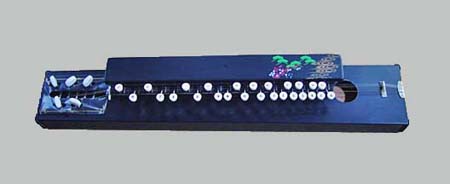
Owner: HWMC
Catalogue #: AS-CHZT-12-14
Zithers
Japan 'Taisho-goto'
Japan
Japanese
Wood, steel strings, mother-of-pearl, paint
Early-Mid 20th century
Length: 27.5 in
Chordophones – Zither
The taishō-goto, also known as Nagoya harp, was developed in 1912 by the musician Gorō Morita in Nagoya, during the early Taisho period (1912-1926 C.E.). Gorō Morita had received a scholarship from the first prime minister of Japan to study musical instruments in Europe and the United States for two years. He subsequently came up with the idea of combining the mechanics of a typewriter with an instrument, which consequently lead to an attempt to modernize the nigenkin, a Japanese zither. He called this new instrument ‘taishō-goto.’
The taisho-goto consists of a long, hollow box with strings running parallel and above the strings are a span of numbered typewriter keys. When the keys are depressed with fingers of the left hand, a bar raises to touch the string causing it to be shorter in length, making it higher in pitch. In the meantime, the player’s right hand uses a plectrum (pick) to strum the strings near the bridge on the right side.
